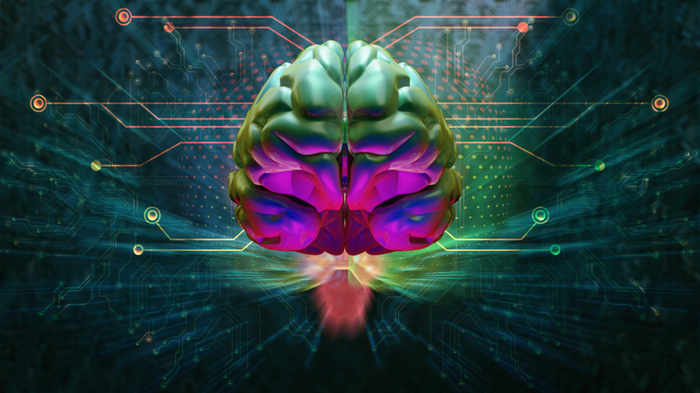MRI image of the human brain showing the curves of neural fibers.mgh-ucla human connectome project
From the 1930s onwards, the American neurosurgeon Wilder Penfield opened the heads of hundreds of people.
It was to cure their epilepsy or remove a tumor, but since he had them open, he applied electric shocks to different parts while he asked the patients what they felt and observed their reactions.
Thus, he was able to create a map with the motor functions of the cerebral cortex.
When drawing it, he came up with a kind of homunculus (little man in Latin) for each hemisphere of the brain.
The drawing showed a series of continuities that still fascinate.
The right index finger, for example, moved by stimulating a point next to the point where the middle finger moves.
Or the movements of the mouth, lips, teeth or larynx are grouped.
The guy has huge hands and head, reflecting the relevance of these body parts.
This discovery and its graphical representation have been in neuroscience textbooks ever since.
The problem is that, according to extensive work carried out now, Penfield's homunculus is poorly drawn.
"This discovery was fortuitous," says Evan Gordon, a neuroscientist at the University of Washington (United States) and first author of this work recently published in
Nature.
.
Along with his lab colleagues, Gordon has spent hours and hours performing MRIs on various people while they were at rest or in motion.
“This allowed us to map the organization of the brain in great detail.
We expected to find many interesting features of the brain's organization of the more complex parts responsible for memory, planning, and abstract thinking.
What we did not expect was to find a new brain system in the primary motor cortex! ”, He details in an email.
“We didn't even consider looking in this area because, since Penfield's work 90 years ago, everyone already knows what the motor cortex is supposed to look like,” he adds.
But what they found was a network within another network that rewrites what was discovered by the Canadian neurosurgeon.
In their attempt to replicate Penfield's maps, the researchers confirmed that the foot control was in the location that the neurosurgeon had identified.
The motor cortex is in the outermost part of the brain and is a kind of strip that starts just above one ear and unfolds until it reaches the other.
This band is interrupted by the separation that, along its length, divides the brain into two parts to the left and right (the interhemispheric fissure).
The movement of the right foot, for example, activates the fringe portion located just on the left edge of this glitch.
They verified the same for the hands (in the middle of the brain surface) and for the face (already close to the auditory pavilion).
More information
The first map of a brain, of a fly larva, brings closer the dream of understanding the human mind
“Penfield wasn't wrong, but he was limited by the technology available at the time,” Gordon clarifies.
In fact, the American neurosurgeon himself said that his homunculus should not be taken at the foot of the stroke.
But what he did miss was that the distribution of body movements on the map of the brain was not linear or continuous, as he believed.
The researchers have now discovered that the movement unfolds concentrically.
Thus, the act of pointing with a finger activates a point in the center of an area in which moving the hand, bending the elbow or shrugging the shoulder activate points further and further away from the center activated by the phalanges.
Mind-body connection
More importantly, interspersed with the key areas for movement of the hands, feet, or face, they saw the activation of other areas that do not appear to be directly involved in motor functions, despite being at the heart of the motor area of the brain. brain.
“We showed that Penfield's homunculus representation is interspersed with areas of a somato [body] cognitive [mind] action network,” Gordon explains.
Standing for SCAN, the various parts of this network are highly connected to each other and are active during many types of moves, and in particular when thinking about executing the move, before actually doing it.
Nico Dosenbach, Gordon's colleague at the University of Washington and a senior author on this research, sees this SCAN network "as an important mind-body interface, perhaps the most important we know of so far."
According to Dosenbach, “it seems to link abstract plans, goals, with all action-relevant bodily functions: skeletal muscle movement (gross motor), smooth muscle (organ) control, autonomic tone (e.g., adrenaline release). )…”.
“SCAN is functionally connected to the regions of the frontal cortex that make plans, make decisions and initiate actions, and it is also connected to the muscles of the body through the spinal cord”, adds the researcher.
The existence of this kind of interface would explain, according to the authors, why so many mental functions and disorders have bodily manifestations.
“When I think about how to solve a problem, I start to walk.
Or, before giving a lecture, I always feel like peeing.
There are a million examples of how your thoughts affect your body.
We believe that the SCAN is the physical structure that makes all this happen”, concludes the neuroscientist.
The charm of the little man
Michael Graziano, a professor at Princeton University and author of books such as
Consciousness and the Social Brain,
(not translated into Spanish, but whose title means Consciousness and the Social Brain) had already begun to dismantle Penfield's heritage at the beginning of this century.
In 2002 he published a paper on the existence of more complex action maps, such as the one activated to speak while breathing, for example, that Penfield's homunculus blurs.
"My work should have ended with the Penfield homunculus," says Graziano bluntly.
“But there were traditionalists who couldn't accept our findings and turned a blind eye to the data.
That is why there are still many followers of Penfield's homunculus and it is still printed in the manuals.
Now this new study is, in a way, a confirmation of what should have already been obvious and helps to move forward”, he adds.
Graziano recognizes that the drawing of the little man has its charm.
“The Penfield muscle map may look fancy, but it is neither necessary nor useful.
The spinal cord already has a map of the muscles.
Why would the bark double it?
The crust is much better at integrating than at separating small engineering units,” he finishes.
The mind does not exist, there is only brain "
Jesús Porta, vice president of the Spanish Society of Neurology
The vice president of the Spanish Society of Neurology, Dr. Jesús Porta, points out that both the work of Graziano and that of Gordon and Donsebach show that "the mind does not exist, there is only a brain."
Since the beginning of the century, research has been accumulating along the lines of considering the mind as a function of the brain: “Music is tangible, but the one who produces it is the orchestra”, compares Porta.
This is much more than a philosophical or metaphysical discussion.
The different functions of the brain, but also its disorders, have their correlate or physical substrate.
As Porta says, “anxiety causes rapid breathing and is accompanied by tachycardia.
It's all brain."
Penfield's homunculus
Wilder Penfield, a doctor and neurosurgeon, in a 1967 image. Boris Spremo/Toronto Star via Getty Images
Wilder Penfield, who in his formative years came to Spain to learn from the Ramón y Cajal team, operated on more than 400 people open-headed.
Most were soldiers from both world wars whose brain injuries had given them focal epilepsy.
He also operated on dozens of brain tumors.
In the course of his interventions, he devised a system to stimulate the various parts of the brain with electrodes and small discharges.
David Ezpeleta, a neurosurgeon at the Quirón University Hospital in Madrid, admits that "that investigation while operating can no longer be done."
The disproportion of the homunculus that Penfield drew to illustrate the map of movements in the motor cortex, with exaggeratedly large hands, feet and face, have their scientific basis.
As Ezpeleta recalls, the different proportions "show that these areas were involved in actions that require more dexterity and fine movement," such as those of the fingers or the tongue.
Beyond the validity and validity of the homunculus, Ezpeleta highlights that Penfield was a pioneer in many aspects, such as epilepsy surgery or the identification and analysis of the motor cortex and the somatosensory cortex.
"He was religious and sought the foundations of emotions, also of the human soul," says Ezpeleta, secretary of the board of directors of the Spanish Society of Neurology.
"In addition to curing, he wanted to find and access the hard drive of our thoughts," he ends.
You can follow
MATERIA
on
,
and
, or sign up here to receive
our weekly newsletter
.

/cloudfront-eu-central-1.images.arcpublishing.com/prisa/ZTBM2HOB5NFCXOSJ77F4A2VSXE.jpg)





